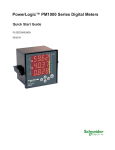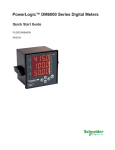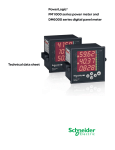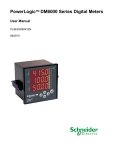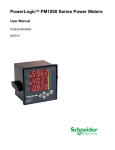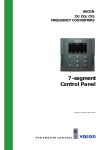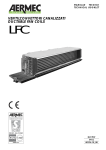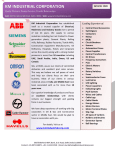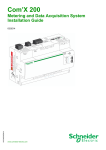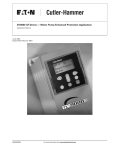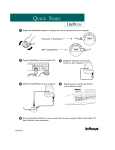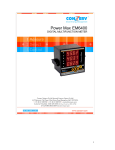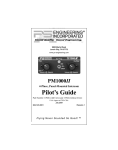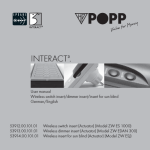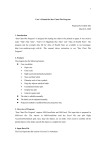Download PowerLogic™ PM1000 Series Power Meters Quick Start Guide
Transcript
PowerLogic™ PM1000 Series Power Meters Quick Start Guide PLSED309038EN 01/2010 PLSED309038EN 01/2010 PM1000 Series Power Meters Quick Start Guide SECTION 1: BEFORE YOU BEGIN SECTION 2: QUICK SETUP Read these instructions carefully and look at the equipment to become familiar with the device before trying to install, operate, service or maintain it. The following special messages may appear throughout this manual or on the equipment to warn of potential hazards or to call attention to information that clarifies or simplifies a procedure. SAFETY SYMBOLS Use CT1 SAFETY MESSAGES 2 Use CT2 Use CT3 4 OTHER SYMBOLS This symbol indicates direct and alternating currents This is double insulation symbol which indicates that, the user accessible area is protected through out by double or reinforced insulation HAZARD OF ELECTRIC SHOCK, EXPLOSION, OR ARC FLASH Apply appropriate personal protective equipment (PPE) and follow safe electrical work practices. In the USA, see NFPA 70E. Only qualified electrical workers should install this equipment. Such work should be performed only after reading this entire set of instructions. The protection provided by the manufacturer will be impaired, if the equipment is not used in the specified manner. NEVER work alone. Before performing visual inspections, tests, or maintenance on this equipment, disconnect all sources of electric power. Assume that all circuits are live until they have been completely de-energized, tested, and tagged. Pay particular attention to the design of the power system. Consider all sources of power, including the possibility of back feeding. Turn off all power supplying the power meter and the equipment in which it is installed before working on it. Always use a properly rated voltage sensing device to confirm that all power is off. Before closing all covers and doors, carefully inspect the work area for tools and objects that may have been left inside the equipment. Use caution while removing or installing panels so that they do not extend into the energized bus; avoid handling the panels, which could cause personal injury. The successful operation of this equipment depends upon proper handling, installation, and operation. Neglecting fundamental installation requirements may lead to personal injury as well as damage to electrical equipment or other property. Building installation shall be included with a disconnecting device like switch or circuit breaker, with clear ON/OFF markings and within close proximity to equipment and the reach of operator, to cut-off the supply mains in case of any hazardous voltages. NEVER bypass external fusing. NEVER short the secondary of a PT. NEVER open circuit a CT; use the shorting block to short circuit the leads of the CT before removing the connection from the power meter. Before performing Dielectric (Hi-Pot) or Megger testing on any equipment in which the power meter is installed, disconnect all input and output wires to the power meter. High voltage testing may damage electronic components contained in the power meter. During the normal operation of this equipment, hazardous voltages might be present at the rear terminals, which can causes severe injury or death. High voltages are likely to be present even after the power meter has been switched off. The power meter should be installed in a suitable electrical enclosure. Failure to follow this instruction will result in death or serious injury 2 RS 485 Only for PM1200 Use PT1 Use PT2 Use PT3 3 1 1. Connect Auxiliary supply (Control power) 44 to 277 VAC/DC to terminals 12 and 13 in order to power ON the power meter. Quick setup when input voltage < 480 VAC LL Keep the TURBO key pressed for 2 Seconds, while powering up the meter. The display will directly enter into the setup menu and display EDIT A.PRI 100.0 This is the simplest way to enter the PROG menu setup. Program the following in your meter for accurate readings. A.pri, A.sec values match your CT primary and secondary values respectively. E.g.: If your CT ratio is 200:5, the A.pri = 200.0 and A.sec = 5.000. If input voltage <480 VAC LL, program the V.pri, V.sec values in the PROG menu to input voltage VLL of the circuit. E.g. if input voltage = 300 VAC LL, V.pri = 300.0 and V. sec = 300.0 Use a Potential Transformer (PT/VT) if input voltage>480 VAC LL Program the V.pri and V.sec to primary and secondary of the PT(VT) respectively. E.g. if your PT(VT) ratio is 11 kV:110 V, V.pri = 11.00 k and V.sec = 110.0 Program the following in your system setup as per your wiring configuration SYS - STAR/WYE for 3-Phase 4-Wire system SYS - DLTA for 3-Phase 3-Wire system SYS - 2 Phase for 2-Phase 3-Wire system SYS - 1 Phase for 1-Phase 2-Wire system 2. Use CT1 CT2 CT3 Terminals 1,2 3,4 5,6 3. Use PT1(VT1) PT2(VT2) PT3(VT3) if voltage exceeds 480 VAC LL Terminals 8 9 10 (11 for neutral) + 4. RS 485 Terminals 7(ve), 14(ve) (Only for PM1200) NOTE: Refer “SECTION 5: PROG MENU SETUP, CLR ” in page 4, for details about PROG menu setup, A.pri, A.sec, V.pri, V.sec etc. © 2010 Schneider Electric All Rights Reserved PLSED309038EN 01/2010 PM1000 Series Power Meters Quick Start Guide Figure 2: 3-Phase 3-Wire Delta Connection with 2 CTs and 3 PTs SECTION 3: INSTALLATION L1 L2 L3 Mechanical and Electrical installation LINE Connecting cable PT Use PT, if VAC LL ³ 481 V VER:03.04.00 > 7.5 A Or 2.5 mm² minimum Screw head Diameter Shaft diameter < 5 mm. Diameter = 5 mm or more will get stuck in the safety cover Torque Tightening Torque: 2.5 to 6 N.m Loosening Torque: 5.5 to 6 N.m Torque greater than 6 N.m may strip the screw or break the Safety Cover. 6 mm less wire thickness Screw Travel Schneider Electric recommends the use of insulated sleeved U lugs (2.5 mm²) for wiring terminals. Don’t use pin lugs which may reduce the safety isolation. 50 mA to 6A Power Driver preferred or hand screw driver Philips tip preferred or flat tip. DO NOT USE POZIDRIV TIP 3.5 mm S/N: COYYWWDXXXX Acc Cl: 1.0 Tools & Equipments Driver Tip 80 t o 480 Vac LL Current Circuit > 600 VAC Current Rating > 0.1 A LOAD 0.25 A 44 to 277 V 50/60 Hz <5 VA > 600 VAC Op t ion Li st : RS 485-TH D-DM-IE Insulation Rating Voltage Circuit Aux supply (Control Power) 44 to 277 VAC/DC Communication (PM1200) RS 485 Figure 3: 3-Phase 3-Wire Open Delta Connection with 2 CTs and 2 PTs L1 L2 L3 LINE Mechanical dimensions and Panel cut-out LOAD 80 t o 480 Vac LL Figure 4: 2-Phase 3-Wire connection with 2 CTs WYE StAR/WyE 1 Delta, Open Delta dLtA 2, 3 2-Phase 2 Ph 1-Phase 1 Ph 4 5 L1 L2 N LINE PT if VAC LL ³ 481 V VER:03.04.00 Figure number Connection diagram symbols 50 mA to 6A S/N: COYYWWDXXXX Acc Cl: 1.0 Description Current transformer (CT) Fuse Shorting block RS 485 LOAD Potential transformer (PT) 80 t o 480 Vac LL Meter configuration 44 to 277 V 50/60 Hz <5 VA System type Op t ion Li st : RS 485-TH D-DM-IE Supported system types Symbol Aux supply (Control Power) 44 to 277 VAC/DC Communication (PM1200) RS 485 Connection Diagrams Use PT, if VAC LL ³ 481 V 0.25 A 44 to 277 V 50/60 Hz <5 VA 90.0 3.54 Op t ion Li st : RS 485-TH D-DM-IE 8.00 0.31 50 mA to 6A 80.0 3.15 S/N: COYYWWDXXXX Acc Cl: 1.0 VER:03.04.00 PT 0.25A Aux supply (Control Power) 44 to 277 VAC/DC Communication (PM1200) Figure 5: Single Phase connection with 1 CT Figure 1: 3-Phase 4-Wire WYE Connection with 3 CTs and 3 PTs L1 L2 L3 N L1 LINE N LINE PT if VAC LL ³ 481 V © 2010 Schneider Electric All Rights Reserved LOAD Communication (PM1200) RS 485 44 to 277 V 50/60 Hz <5 VA VER:03.04.00 Aux supply (Control Power) 44 to 277 VAC/DC Op t ion Li st : RS 485-TH D-DM-IE 50 mA to 6A VER:03.04.00 RS 485 0.25 A S/N: COYYWWDXXXX Acc Cl: 1.0 44 to 277 V 50/60 Hz <5 VA Op t ion Li st : RS 485-TH D-DM-IE S/N: COYYWWDXXXX Acc Cl: 1.0 50 mA to 6A LOAD 80 t o 480 Vac LL Use PT, if VAC LL ³ 481 V 80 t o 480 Vac LL PT 0.25 A Aux supply (Control Power) 44 to 277 VAC/DC Communication (PM1200) 3 PM1000 Series Power Meters Quick Start Guide SECTION 4: KEYPAD SETUP Keypad description Right Key: Go forward to sub-parameters page. Left Key: Opposite to right key. Go back towards main parameters page. Up Key: Scroll up through the display pages at the level, within the same function Down Key: Opposite of up key. Scroll down through the display pages at the same level through all the functions TURBO Key: TURBO key is the simple one touch access to the most commonly used parameters pages (Factory set) even for the unskilled operators. The TURBO pages for PM1000series power meters are RMS (Home page), VLL A PF, VLN A F, VA W PF VA, W VAR W, VAR, PF PF1 PF2 PF3, V% 1 2 3 A % 1 2 3, VAd RD TR, MD HR, VAh, Wh, RVAh, RWh, tVAh, tWh. If you are lost TURBO key is the quick way to get back to the RMS page. See the online PM1000 User Manual at www.powerlogic.com for more information on keys and other features. Keypad operation SECTION 5: PROG MENU SETUP, CLR PROG menu - Setup Setup menu gives the complete list of user-programmable parameters. The power meter must be set (programmed/configured) to match the application settings, before use. Otherwise, the readings will be wrong. All the Setup values can be re-programmed at any time, upon entering SET. However, the settings: SYS (Star/wye or Delta or 2-Phase or 1-Phase), Vpri, Vsec, Apri, Asec critically determine the scaling of measured readings. While the scaling may be used to minimize the error in readings due to Instrument Transformer errors, wrong settings will upset the readings of running systems. You can enter Setup menu in Edit mode – to view or edit set parameters View only mode – to view the set parameters HAZARD OF UNINTENDED OPERATION Only qualified personnel are authorized to setup the power meter. Failure to follow these instructions can result in injury or equipment damage. Enter setup menu in View (Read-Only) mode SET Navigation Concept RMS VLL A PF PLSED309038EN 01/2010 V12 23 31 VLN A F VIEW VIEW A.PRI 100.0 CLR RMS 1. From RMS press up . The display shows CLR. 2. Press . The display shows SET. 3. Press . The display shows VIEW. 4. Press , You can view the setup parameters. Enter setup menu in Edit mode SET VIEW Let us take an example to understand the actions of the front panel keys in the RMS menu. This example will explain how you can navigate from the RMS page to the VLN A F page, back to RMS in PM1000 series power meters. CLR EDIT From the RMS page use the right key . The display shows VLL A PF. The Right key can be used to go forward into sub-parameter pages. Now press the down key You can scroll down through other pages at the same level using down key . The display shows VLN A F. Congratulations you have successfully navigated from RMS to VLN A F To return to RMS press the left key . The display shows RMS Using the left key you can go backwards to the main parameter pages from sub-parameter pages. RMS 4 NOTE: CODE 2 000 CODE 1 000 PASS EDIT A.PRI 100.0 indicates blinking/editable 1 means blinking 2 1. From RMS press up . The display shows CLR. 2. Press . The display shows SET. 3. Press . The display shows VIEW. 4. Press . The display shows EDIT. CODE entry is required to edit the setup parameters. 5. Press key for 2 Seconds. The display shows CODE 2000 with blinking 2. 6. The factory set CODE is 1000. 7. Press . The display shows CODE 1000 with blinking 1. 8. Press key once or key 4 times to accept the new CODE value. 9. The display flashes PASS and then EDIT A.PRI 100.0 indicating the successful entry to setup menu in Edit mode. © 2010 Schneider Electric All Rights Reserved PLSED309038EN 01/2010 PM1000 Series Power Meters Quick Start Guide SECTION 5: PROG MENU SETUP, CLR (Cont’d) Setup parameters in View & Edit modes Edit Set parameters This example explains how to edit the A.SEC from 5.000 to 1.000 in the Edit Setup menu of PM1000 series power meters. For easy understanding the setup editing is explained in two sections VIEW MODE EDIT MODE VIEW A.PRI 100.0 EDIT A.PRI 100.0 A.PRI= Current primary winding (CT)* Input range: 1 A to 99 kA (100.0) VIEW A.SEC 5.000 EDIT A.SEC 5.000 A.SEC= Current secondary winding (CT) (5.000) VIEW V.PRI 415.0 EDIT V.PRI 415.0 V.PRI= Voltage primary winding (PT), line-line* Input range: 100 V to 999 kV(415.0) VIEW V.SEC 415.0 EDIT V.SEC 415.0 V.SEC= Voltage secondary winding (PT), line-line* Input range: 80 V to 480 V ( 415.0) VIEW SYS STAR EDIT SYS STAR VIEW LABL 123 EDIT LABL 123 LABL= Phase labeling Select from: 123, RYB, RST, PQR, ABC VIEW VA.Fn 3D EDIT VA.Fn 3D VA.FN= VA function selection* Set the VA function to: 3D, ARTH VIEW d.SEL AUTO EDIT d.SEL AUTO d.SEL = Demand Selection* Select from: auto, user VIEW d.PAR VA EDIT d.PAR VA d.PAR = Demand Parameter* Select from: VA, W, A VIEW d.PRD 15.00 EDIT d.PRD 15.00 d.PRD = Demand Period Select from: 5, 10, 15, 20, 25, 30 VIEW BAUD 9600 EDIT BAUD 9600 BAUD= Baud rate Select from: 1200, 2400, 4800, 9600, 19200 VIEW PRTY EVn1 EDIT PRTY EVn1 PRTY= Parity & Stop bit settings:EVN.1 , EVN.2, ODD.1, ODD.2, no.1, no.2 VIEW ID 1.000 EDIT ID 1.000 ID = RS485 Device ID number:001 to 247. (Evn.1 = Even.1 stop bit) VIEW F.S% 100.0 EDIT F.S% 100.0 F.S%= Full scale % Set the full scale between 1 to 100 VIEW OFLO Wh EDIT OFLO Wh OFLO = Overflow parameter selection: Wh, VAh; INTG clears when 9999 Run hours (almost 13.88 months) VIEW POLE 4.000 EDIT POLE 4.000 POLE = Number of poles for RPM Select from: 2, 4, 6, 8, 10, 12, 14, 16 Edit & Accept setup SET VIEW CLR EDIT RMS CODE 2 000 CODE 1 000 PASS EDIT A.PRI 100.0 EDIT A.SEC 5.000 SYS= Power system's configuration* Select from: STAR, DELTA, 2-Phase, 1-Phase, WYE EDIT A.SEC 5. 000 EDIT A.SEC 1. 000 EDIT A.SEC 1.000 NOTE: indicates blinking/editable 2 means blinking 2 1. After the successful entry to setup menu in edit mode (Refer “Enter setup menu in Edit mode” in page 4), press . The display shows EDIT A.SEC 5.000. 2. Press . The display shows EDIT A.SEC 5.000 with blinking 5 i.e, the value can be edited. 3. Press four times. The display shows EDIT A.SEC 1.000 with blinking 1. 4. Press once to accept the new value 5. If you want to edit next parameter, press and repeat the steps. To save new value to setup A.SEC 1.000 NOTE: indicates blinking/editable y means blinking y 1. After completing the parameter editing as above press . The display shows SAVE y with y blinking. Go to step 4 to not save the new value. 2. If you want to save the new value, press or key. 3. The display flashes PASS and then EDIT. Go to step 7. 4. Press . 5. The display shows SAVE n with n blinking. 6. Now press or key. The display flashes FAIL and then shows EDIT. 7. Press to return SET. NOTE: Default Setup values are given in BOLD *Changing these values while the device is in use, is not recommended. BAUD, PRTY & ID are applicable only for PM1200. © 2010 Schneider Electric All Rights Reserved 5 PM1000 Series Power Meters Quick Start Guide PLSED309038EN 01/2010 SECTION 5: PROG MENU SETUP, CLR (Cont’d) CLR INTG & MD SECTION 6: ENERGY INTEGRATOR INTG, OLD, OVERFLOW PM1000 series power meters are equipped with INTG , where the energy parameters are accumulated. Energy Integrator INTG INTG clear - clears both INTG and MD MD clear - clears only MD where MD is maximum demand CODE 2 000 CODE 1 000 PASS Your PM1000 series power meter is equipped with an Energy Integrator function which provides several parameters for Energy Management: VAh, Wh, VARh (Ind), -VARh (Cap), RUN.h (run hours), ON.h (on hours), INTR (Interruptions / outages). All the values stored in INTG are direct readings and have high resolution A few of these need explanation: RUN.h: Indicates the period the Load is ON and has run. This counter accumulates as long as the load is ON. ON.h: The period for which the Auxiliary Supply (control power) is ON INTR: Number of Supply Outages, means the number of Auxiliary Supply interruptions. If the meter Auxiliary Supply is from a UPS then the INTR (number of interruptions) will be zero (as long as the UPS stays ON), even if the Voltage Signals did die out from time to time. Integrator Overflow NOTE: indicates blinking/editable y means blinking y INTG CLR 1. From RMS, Press . The display will show CLR. 2. CODE entry is required to clear the INTG values. 3. Press for 2 Seconds. The display will show CODE 2000 with blinking 2. The factory set CODE is 1000. 4. Press . The display will show CODE 1000 with blinking 1. 5. Press key once or four times to accept the new value 6. After the successful CODE entry, the display shows CLR INTG. 7. In order to clear INTG press key. The display shows CLR INTG y with blinking y. Go to step 9 to not clear the INTG. 8. Press key to clear INTG. The display flashes PASS and then CLR INTG. Go to step 11 9. Press key. The display shows CLR INTG n with blinking n. 10. Press key. The display flashes FAIL and then CLR INTG. 11. Press key. The display shows CLR means exit 12. Press key to return to RMS page. MD CLR 1. From RMS, Press . The display will show CLR. 2. CODE entry is required to clear the MD values. 3. Press for 2 Seconds. The display will show CODE 2000 with blinking 2. The factory set CODE is 1000. 4. Press . The display will show CODE 1000 with blinking 1. 5. Press key once or four times to accept the new value 6. After the successful CODE entry, the display shows CLR INTG. 7. Press key. The display shows CLR MD. 8. In order to clear MD press key. The display shows CLR MD y with blinking y. Go to step 10 to not clear the MD. 9. Press key to clear MD. The display flashes PASS and then CLR MD. Go to step 12. 10. Press key. The display shows CLR MD n with blinking n. 11. Press key. The display flashes FAIL and then CLR MD 12. Press key. The display shows CLR means exit 13. Press key to return to RMS page. 6 The energy values stored in INTG is based on V.Pri x A.Pri and independent of secondary value of V and A. The energy value readings will overflow based on V.Pri x A.Pri of the primary settings in setup, when 9999 run hours is reached. The energy parameter for overflow is user selectable (Wh or VAh) through setup, by default it is Wh or by the Run hours which is fixed 9999 Run hours (almost 13.88 months). For power systems ranging from 1 VA to 1000 MVA, the integrator will overflow at 9999 run hours. The duration required for the integrator to overflow will be 13.88 months if the power meter is constantly running at full scale. However in case of power systems greater than 1000 MVA, the integrator will overflow at a value lesser than 9999 run hours. The duration required for the integrator to overflow will be less than a year if the meter is constantly running at full scale. V.PRI x A.PRI x 1.732 Max Reading Max time to reset Max time to overflow in the integrator in months at full scale (Wh/VAh) Run Hours 1 VA to 1000 VA 9999 k 9999 13.88 1 kVA to 1000 kVA 9999 M 9999 13.88 1 MVA to 1000 MVA 9999 G 9999 13.88 <9999 < 1 year >1000 MVA OLD data register When the Integrator is cleared (manually or due to overflow), the energy values stored in the integrator will be transferred to OLD register. Thus the old energy values are not lost even after the integrator is cleared and can be viewed with the OLD parameter. NOTE: For energy studies clear the Integrator at the end of each observation. This will, transfer all the stored energy values to the OLD register and held frozen, while the Integrator begins accumulating data for the next observation. Remember that the next time the Integrator is cleared, the OLD values will be over-written. © 2010 Schneider Electric All Rights Reserved PLSED309038EN 01/2010 PM1000 Series Power Meters Quick Start Guide SECTION 7: PM1000 SERIES MENU HIERARCHY 4 3 1 V 12 23 31 RMS VLL A PF V 1 2 3 A 1 2 3 L%1 2 3 VLN Aº 1 A 2 F 3 RMS = RMS value display pages are in sub level VLL = Phase-Phase voltage average A = Current average PF = Power Factor average VLN = Phase-Neutral voltage average A = Current average F = Frequency in Hz VA = Apparent power total W = Active power total PF = Power factor average V12 = RMS voltage, phase 12 V23 = RMS voltage, phase 23 V31 = RMS voltage, phase 31 V1 = RMS voltage phase 1 to neutral V2 = RMS voltage phase 2 to neutral V3 = RMS voltage phase 3 to neutral A1 = RMS current, phase 1 A2 = RMS current, phase 2 A3 = RMS current, phase 3 INTG VAh Fwd Wh INTG Fwd = Forward Integrator VAh = Fwd Volt-ampere hours Wh = Fwd Watt hours VARh VARh = Fwd Reactive energy, inductive -VARh Run.h INTG R.VAh Rev R.Wh -VARh = Fwd Reactive energy, capacitive Run.h = Fwd Run hours INTG Rev = Reverse Integrator R.VAh = Reverse Volt-ampere hours R.Wh = Reverse Watt hours A.UNB V.UNB RPM An VA W PF VA W VAR A00 1 2 3 DM VA VAd Rd TR MD HR 1 A°1 = Current phase angle, phase 1 in degrees A°2 = Current phase angle, phase 2 in degrees A°3 = Current phase angle, phase 3 in degrees -R.VAR R.VAR = Reverse Reactive energy, inductive -R.VAR = Reverse Reactive energy, capacitive R.Run R.Run = Reverse Run hours A.UNB = Current unbalance V.UNB = Voltage unbalance RPM = RPM of the motor W1 2 3 An = Neutral current t.Wh t.VAh = Total Volt-ampere hours VA1 = Volt-amperes, phase 1 VA2 = Volt-amperes, phase 2 VA3 = Volt-amperes, phase 3 t.VAR t.Wh = Total Watt hours W1 = Watts, phase 1 W2 = Watts, phase 2 W3 = Watts, phase 3 -t.VAR t.VAR = Total Reactive energy, inductive t.Run -t.VAR = Total Reactive energy, capacitive W VAR PF PF 1 2 3 V00 1 2 3 R.VAR VA 1 2 3 VAR1 2 3 THD L1% = % of load, phase 1 L2% = % of load, phase 2 L3% = % of load, phase 3 VAR1 = VAR, phase 1 VAR2 = VAR, phase 2 VAR3 = VAR, phase 3 PF1 = Power factor, phase 1 PF2 = Power factor, phase 2 PF3 = Power factor, phase 3 INTG t.VAh TOT On.h INTG TOT = Total Integrator t.Run = Total Run hours On.h = Duration of supply ON INTR INTR = No of power interruptions THD = Total Harmonic Distortion V00 1 = Voltage THD, Phase 1 V00 2 = Voltage THD, Phase 2 V00 3 = Voltage THD, Phase 3 2 A00 1 = Current THD, Phase 1 A00 2 = Current THD, Phase 2 A00 3 = Current THD, Phase 3 DM VA = VA Demand VAd = VA demand Rd = Rising demand TR = Time remaining MD = Maximum demand HR = On hours at which maximum demand has occured © 2010 Schneider Electric All Rights Reserved 7 PLSED309038EN 01/2010 PM1000 Series Power Meters Quick Start Guide 2 OLD Fwd = OLD Forward Integrator OLD VAh Fwd VAh = OLD Fwd Volt-ampere hours Wh Wh = OLD Fwd Watt hours VARh VARh = OLD Fwd Reactive energy, inductive -VARh -VARh = OLD Fwd Reactive energy, capacitive Run.h Run.h = OLD Fwd Run hours OLD Rev = OLD Reverse Integrator OLD R.VAh Rev R.VAh = OLD Reverse Volt-ampere hours R.Wh R.Wh = OLD Reverse Watt hours R.VAR R.VAR = OLD Reverse Reactive energy, inductive -R.VAR -R.VAR = OLD Reverse Reactive energy, capacitive R.Run R.Run = OLD Reverse Run hours OLD t.VAh TOT OLD TOT = OLD Total Integrator t.Wh t.VAh = OLD Total Volt-ampere hours t.Wh = OLD Total Watt hours t.VAR -t.VAR t.Run 3 t.VAR = OLD Total Reactive energy, inductive -t.VAR = OLD Total Reactive energy, capacitive t.Run = OLD Total Run hours DIAG Dia1 DIAG = represents diagnostic pages. The values contained in these pages are for factory testing only Dia2 Dia1 = Communication settings Dia3 SET VIEW EDIT CLR Dia2 = Product model and version number Dia3 = Display scanning for display LED check SET = Has two modes EDIT/VIEW set parameters VIEW = To view simultaneous setup parameter name and value display EDIT = To edit simultaneous setup parameter name and value display CLR = Clears INTG and MD values 4 Schneider Electric Industries SAS 35, rue Joseph Monier CS 30323 F - 92506 Rueil-Malmaison Cedex PowerLogic is either trademark or registered trademarks of Schneider Electric. For technical support: [email protected] (00) + 1 250 544 3010 Electrical equipment should be installed, operated, serviced, and maintained only by qualified personnel. No responsibility is assumed by Schneider Electric for any consequences arising out of the use of this material. Contact your local Schneider Electric sales representative for assistance or go to www.schneider-electric.com. © 2010 Schneider Electric All Rights Reserved PM1000 QSG v03.04.00.d10








